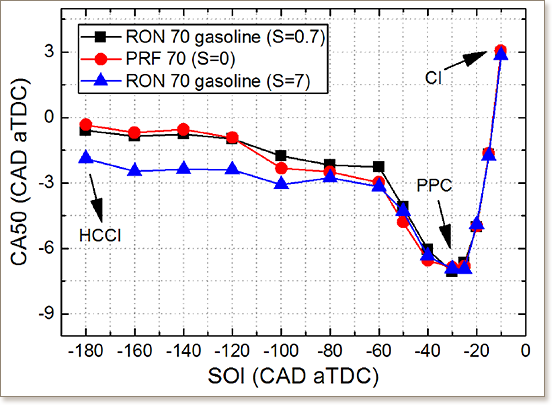The physical and chemical effects of fuel on gasoline compression ignition
R. Vallinayagam, P. Hlaing, A. AlRamadan, Y. An, J. Sim, J. Chang, B. Johansson
SAE Technical Paper, 2019-01-1150, (2019)

In the engine community, gasoline compression ignition (GCI) engines are at the forefront of research and efforts are being taken to commercialize an optimized GCI engine in the near future. GCI engines are operated typically at Partially Premixed Combustion (PPC) mode as it offers better control of combustion with improved combustion stability. While the transition in combustion homogeneity from convectional Compression Ignition (CI) to Homogenized Charge Compression Ignition (HCCI) combustion via PPC has been comprehensively investigated, the physical and chemical effects of fuel on GCI are rarely reported at different combustion modes. Therefore, in this study, the effect of physical and chemical properties of fuels on GCI is investigated. In-order to investigate the reported problem, low octane gasoline fuels with same RON = 70 but different physical properties and sensitivity (S) are chosen. Fuels with comparable sensitivity and RON are chosen to study the impact of physical properties on GCI. On the other hand, by keeping the same RON and physical properties, the effect of sensitivity on GCI is investigated. In this regard, three test fuels such as RON 70 gasoline (S=0.7), PRF 70 (S=0) and RON 70 gasoline (S=7) are chosen in the present study. Herein, RON 70 gasoline (S=0.7) and PRF 70 have similar RON and sensitivity but different physical properties; however, RON 70 gasoline (S=0.7) and RON 70 gasoline (S=7) have the same RON and physical properties but different sensitivity. These test fuels were tested in a heavy-duty CI engine at a compression ratio of 17.8 under different combustion modes. The experimental investigation reveals that RON 70 gasoline (S=0.7) and PRF 70 (S=0) behaves the same in terms of combustion behavior (combustion phasing, ignition delay, in cylinder pressure and rate of heat release) regardless of the difference in physical properties. While nitrogen oxide (NOX) and soot emissions are comparable between RON 70 gasoline (S=0.7) and PRF 70 at all combustion modes, the hydrocarbon (HC) and carbon monoxide (CO) emissions are slightly higher for PRF 70 when compared to RON 70 gasoline (S=0.7) at HCCI mode but not at PPC and CI modes due to the impact of physical properties. On the other hand, due to higher sensitivity, the reactivity for RON 70 gasoline (S=7) is improved to advance the combustion phasing at HCCI combustion mode when compared to RON 70 gasoline (S=0.7). At HCCI mode, the HC emissions are lower for high sensitive gasoline when compared to low sensitive gasoline whereas they are comparable at PPC and CI combustion modes. The NOX and soot emissions are comparable at HCCI modes whereas high sensitivity gasoline shows slightly decreased NOX and increased soot emissions, respectively, at PPC and CI combustion modes when compared to low sensitive gasoline.